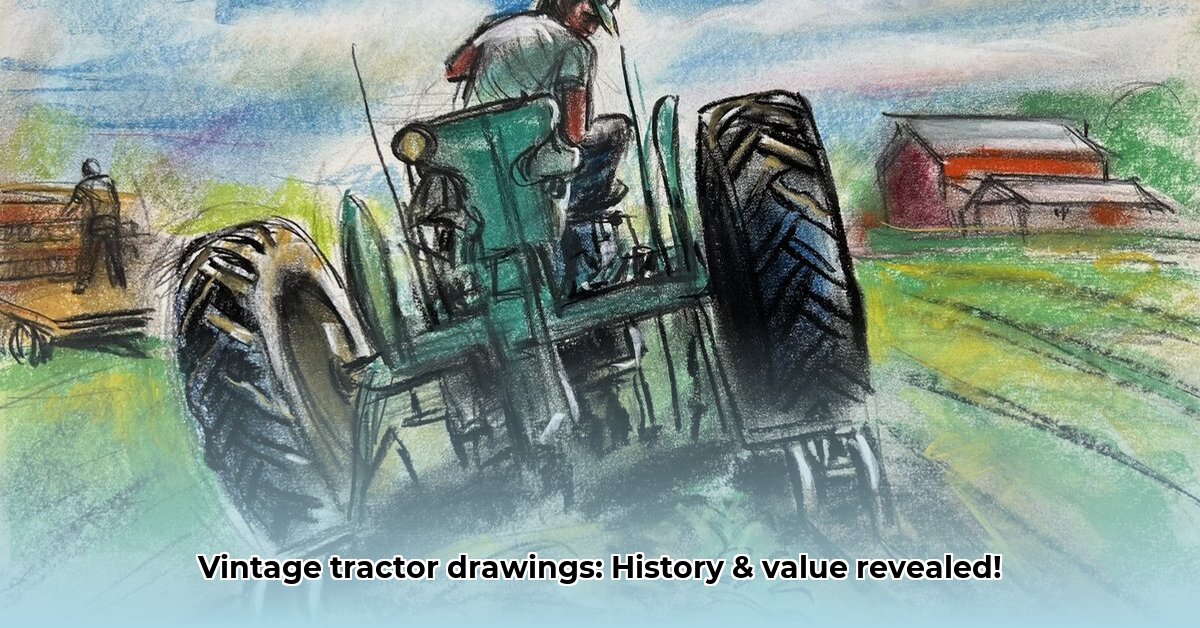
The rumble of a vintage tractor, the scent of freshly turned earth – these evoke a powerful sense of nostalgia. But have you ever considered the art that captures these machines? Old tractor drawings aren't just technical illustrations; they're a visual history, a testament to both engineering prowess and artistic expression. This guide delves into the captivating evolution of these drawings and the surprising market that's sprung up around them. Are these charming images merely nostalgic relics, or a burgeoning investment opportunity? Let's explore. For more simple tractor drawings, check out this helpful resource.
A Century of Steel and Ink: From Blueprint to Beautiful
Early tractor illustrations were purely functional – precise line drawings resembling engineering schematics. These Victorian-era engravings emphasized every bolt and gear, prioritizing information over aesthetics. Yet, even these early depictions possess a stark beauty in their meticulous detail and shading. But the art of depicting these mechanical marvels didn't remain static.
The 1920s and 30s saw a shift towards more stylized depictions, reflecting the Art Deco flair of the era. Tractors became powerful symbols of progress, represented with smooth lines and bold colors. Post-war illustrations often embraced realism, capturing the growing complexity of farm machinery. The advent of digital tools introduced hand-drawn vector art, offering clean lines perfect for reproduction. Even caricature found its place, adding a touch of humor. This stylistic evolution mirrors the changing perception of tractors – from essential tools to symbols of a bygone era. How have these artistic shifts impacted the market value of vintage tractor illustrations?
The Market for Vintage Tractor Art: A Surprisingly Diverse Field
The market for old tractor drawings is far from monolithic. It's a diverse ecosystem comprised of several interconnected segments: high-volume stock illustration websites, a passionate collector's market focusing on originality and authenticity, and the ever-expanding digital realm. What are the key distinctions between these different marketplaces?
Stock illustration sites, such as iStockphoto, offer thousands of images for commercial use, creating a highly competitive market driven by versatility and a wide range of styles. In contrast, collectors seek unique, original artwork, viewing some drawings as valuable historical artifacts reflecting agricultural innovation. This raises a crucial question: How has the rise of easily accessible digital platforms altered the landscape of this diverse market?
Analyzing the Players: Who's in the Driver's Seat?
The market is populated by distinct players, each with their own motivations:
| Stakeholder | Motivations | Impact of Digitalization |
|---|---|---|
| Stock Illustration Sites | High-volume image provision for commercial use at competitive prices. | Increased competition, but also access to a larger global market. |
| Artists | Creation and sale of original artwork, brand building, reputation enhancement. | Wider reach, but also heightened price competition. |
| Collectors | Acquisition of unique, historically significant pieces; appreciation of craftsmanship. | Easier access to information, but also intensified competition among buyers. |
| Agricultural Tourism Operators | High-quality images for marketing and brand building, enhancing brand appeal. | Easier image sourcing, stronger visual identities. |
The Future of the Plow: Where Are Old Tractor Drawings Headed?
The demand for vintage tractor drawings remains dynamic, fueled by growing interest in agricultural heritage tourism. Artists specializing in niche markets, perhaps focusing on specific tractor models or unique artistic styles, are likely to thrive. Collaborations between artists and heritage organizations offer exciting opportunities, enriching the artistic appreciation of these machines alongside their historical significance. Will the trend towards vintage aesthetics continue to drive demand?
The future likely holds even greater stylistic diversity. The fusion of traditional and digital techniques promises exciting developments, blending classic pen-and-ink with modern enhancements. This narrative, far from over, continues evolving, reflecting both technical advancements and shifts in artistic expression, guaranteeing a dynamic future for vintage tractor illustrations.
How to Price Vintage Tractor Illustrations for Commercial Use
Pricing vintage tractor illustrations hinges on several crucial factors: artist reputation, image uniqueness, resolution, and licensing. Understanding the target market—original art, stock illustrations, prints—is paramount for effective pricing. High-resolution scans fetch higher prices than low-resolution counterparts. Careful research into comparable works and licensing fees is essential. A successful pricing strategy balances market demand with the artist's investment of time and skill.
Key Takeaways:
- Pricing depends on artist reputation, image uniqueness, resolution, and intended use.
- Understanding market segments (original art, stock illustrations, prints) is crucial.
- Digital platforms impact value; high-resolution scans command higher prices.
- Research comparable works and consider licensing fees.
- Balancing market demand with artistic investment is essential for profitable pricing.